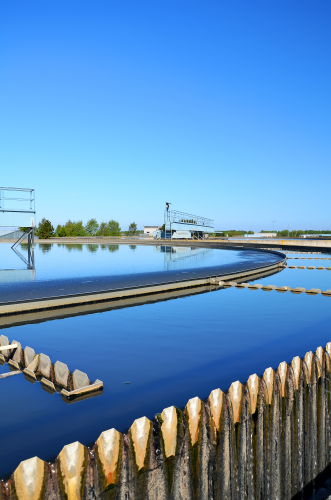
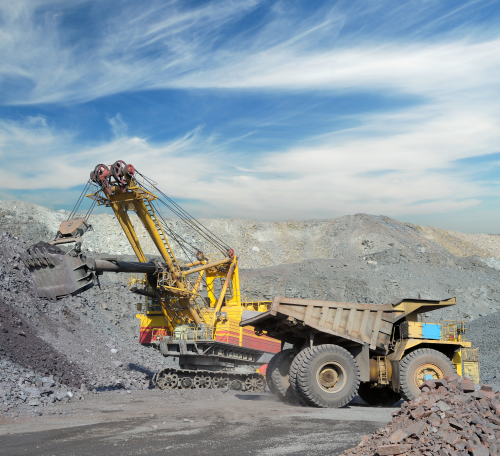
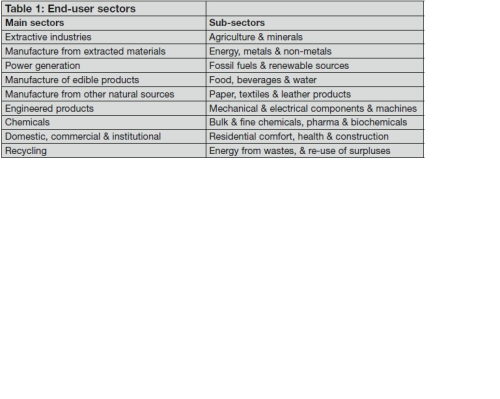
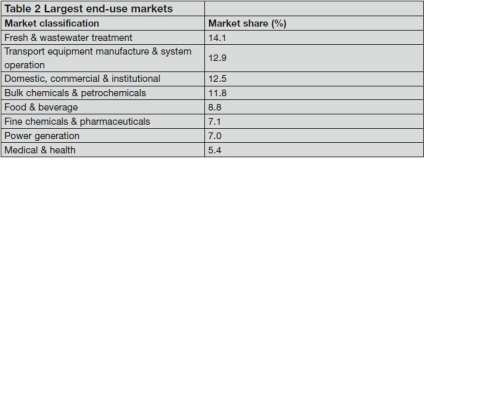

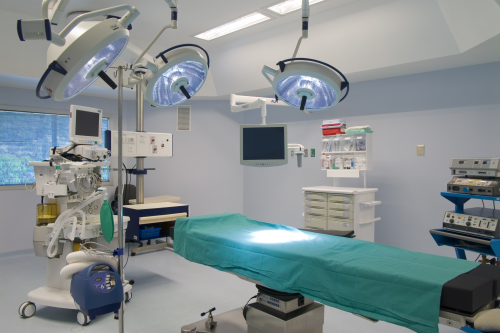
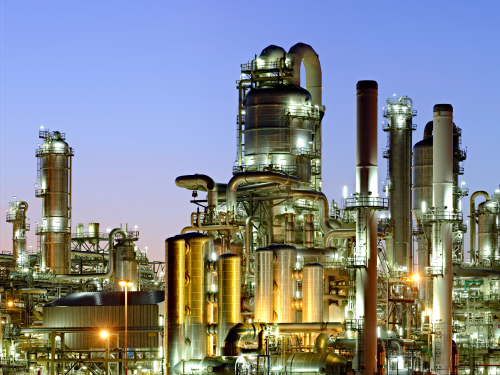
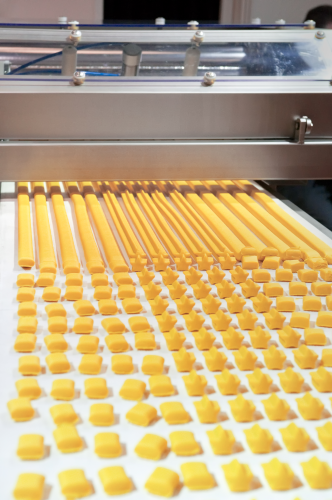
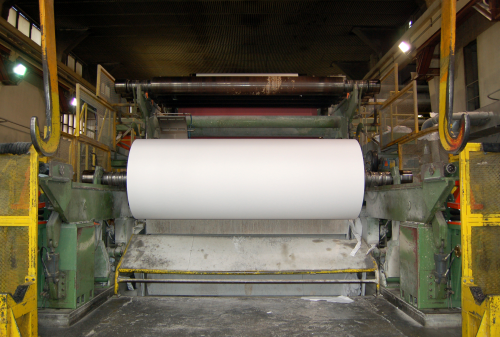
The filtration business is fortunate in that its products are widely used throughout industry and commerce, such that a downturn in one part of its market can be offset by expansion in another. The full marketplace is described by the classification of Table 1, which shows the whole gamut of industrial and commercial activity, arranged by type of end-use. The classes given in Table 1 are by no means of equal importance in filtration terms, and an attempt, as this is, to describe the more important equipment and media developments over a significant time period, must be restricted in its coverage – or take up the whole of this issue. The more important classes of activity are listed, in their order of current sales volume, in Table 2 (as a percentage of the total marketplace for filtration and separation, including filter media). The classes listed in Table 2 are reasonably similar to the relevant ones of Table 1, and these are the application areas that will be considered for the bulk of this article.
Water
The production of clean water, and the treatment of wastewaters, together make up the largest end-use application sector, and also one of the fastest growing. There are four major applications in the whole water sector: • The conventional purification of water, drawn from surface or underground sources, to provide a safe drinking quality; • The further treatment of potable water for use in specific, ultrapure industrial applications; • The treatment of unconventional sources of water; and • The purification of waste waters from all sources to render them safe for discharge into the environment. For a very long time, the production of drinking water and the treatment of waste were the only applications in this sector. The arrival of membrane separation processes on the scene 60 years ago, however, has created great changes in the traditional treatment systems, and built large markets out of the other two activities. The market’s needs for extremely pure process water are being met by the application of ultrafiltration membranes, while the full range of membranes is being employed to bring the unconventional sources to market: by the desalination of salt and brackish waters; by the collection and recycling of rain water and of grey water from residential and institutional premises; by the recycling of treated wastewater for industrial purposes and, as public conceptions change to accept the idea, the recycling of municipal wastewaters as drinking water. The processing needs lying behind these extensions to the traditional are almost all directed at higher product water quality, and have resulted in appropriate improvements in equipment and filter media: more efficient clarifiers; multilayer deep bed filters; centrifugal decanters for sludge dewatering, and, of course, the wide range of membranes. In addition to particle removal, the filtration system may need to address the removal of oil droplets from suspension in the feed water, or the removal of the colloidal or large dissolved organic molecules that are usually responsible for unpleasant tastes or odours or colour in the water, or the removal of the large dissolved ions from inorganic salts responsible for causing hardness in the water, or, finally, the removal of the smaller ions causing salinity (or, more correctly in this case, the removal of pure water from residual brine), as well as the residual solids produced in the solid waste treatment processes. All of these separations are now achievable by modern equipment, largely developed over the past 50 years.
Transport systems
The manufacturers of transport equipment of all kinds, and even more the operators of systems using it, are responsible for the purchase of vast numbers of relatively small and simple filters. In addition to the filters used in the transport equipment manufacturing process – for machine tool coolants, pneumatic and hydraulic systems, this sector covers all of the filter media fitted into the equipment made in the manufacturing processes, for its engines and encompassing vehicles - which are then identical to those used as replacement parts during the life of the equipment. The normal modern automobile or commercial vehicle has filters for engine fuel and lubricants, for intake (combustion) air, and for cooling water. Other systems in the vehicle that use filters include suspension, automatic braking, power steering, crankcase and safety airbags. The air conditioning unit, an increasingly common accessory, will include a filter, and, throughout the sector, filters are being fitted for cabin air, to remove pollen, dust, and the fumes generated by other vehicles, and so increase the comfort of driver and passengers. Exhaust filters are not yet a common feature of the private car, but will almost certainly become necessary, at least for diesel-engined vehicles. This combination of variety of filter type, with the numerical size of the vehicle component, provides a large market for suppliers of filters and filter media – the modern car can include 50 or more filters when on the road. The basic engine filters have been part of this sector for a long time, but cabin air filters and combustion exhaust filters will give the sector a considerable boost.
Domestic, commercial and institutional
The clean air and clean water needs of people at home or at work, or involved with indoor leisure activities, have created a huge demand for relatively simple filters. The applications covered here are the domestic dwelling (house or apartment), the working office, hotels and restaurants, theatres and cinemas, etc (but excluding offices where they are covered by the industry sector to which the office corresponds, nor industrial clean room systems, nor respirators for factory workers). Whilst the individual filter installation in any home or office may be a tiny part of the cost of the whole building, the huge numerical volumes of their application creates a very large market, with a great degree of conformity across it. There are approximately 150 million households in Western Europe, over 100 million in the USA, and similar numbers (albeit growing rapidly) in East Asia. The number of offices around the world is at least another 100 million. It takes very little by way of coffee, vacuum cleaner, air conditioner and drinking water filters in each of these to create a large market from this number of end users – a creation mainly of these fifty years – and that still leaves swimming pool filters, cooker fume hoods and replacement filters for the family car to add to its size. In most of the world the demand for cleaner water and for better air quality is increasing rapidly, and is leading to a major component of the filter market, largely met by the pleated nonwoven filter.
Medical and health
The provision of medical and health care services is, in principle, not much different from the overall domestic sector, just described. However it is kept separate in this analysis because of the dominance of membrane processes in its main application, haemodialysis, which became available in the 1940s. Membrane processing and haemodialysis have thus developed almost contemporaneously. Kidney failure is unlikely to be eradicated just yet, so this will continue to be an important business sector for filters.
Chemicals
The two chemicals sectors, listed in Table 2, which together categorise the overall chemicals industry, can be seen to make up a total of almost one-fifth of the total separation equipment market. This whole chemicals sector is distinguished in filtration terms by its employment of the complete range of filtration equipment, including all of the more complicated, process types, as well as all of the simpler utility filters. As the sector’s equipment needs have changed, so has the filtration industry’s ability to meet these changing needs. The process applications are found widely throughout the chemicals sector, usually very specific to its industrial processes, and with important variations in design and construction imposed on them by the process operating temperatures and pressures, by the corrosiveness of the liquid or abrasiveness of the solids in the system, and by the individual process needs, such as filter cake dryness or filtrate clarity. Many of the largest separating devices are to be found in the chemicals sector, often working continuously, as are many of the pressurised filters and those operating under vacuum. The great majority of corrosive environments are here, as are most of the high temperature (greater than 100°C) fluid systems. So the sector’s filters are equipped with appropriately resistant filter media, many of which have been developed to meet the needs of chemical processes. For much of the past half-century, equipment design has concentrated on increasing the throughput of the process filter (for example, increasing the filter belt width and operating speed of a vacuum belt filter), and on decreasing the labour costs of the process (for example, making a filter press more automatic in its operation). There has been a slow changeover from filters to solids-separating centrifuges, because of the greater ease of solid product handling (the more difficult the solids removal task, the more complex the filter construction). The most visible change in the chemicals sector has been the increasing investment in pharmaceutical and biotechnical processes, where the trend has actually been towards smaller processing units, and much more refined processing, partly because of the higher unit values of the material undergoing processing. The equipment design has become much more precise, and the development of the membrane has been a huge benefit, especially to the smallest scale operations. The majority of these operations are carried out in the liquid phase, with solid suspensions being very common, so that the use of filtration and centrifugation is widely found, as a solid recovery step, or in purifying ingredients, intermediates or final products, in the recycling or treatment of waste streams and in protective systems for the manufacturing processes. An important characteristic of the biotechnical sector is that of scale. Whilst several of its processes are large (bioethanol, antibiotics), the majority of biotechnical applications are small, verging sometimes on the microscopic. Not only does this usually call for batch operation, but also the equipment must be extremely precisely designed. Some of its products (or by-products) can be very toxic. Operating systems then need to be very secure, with all entry and exit points well protected against leakage of process materials into the surrounding environment. The reverse situation is also true that most biotechnical processes are very delicate and so are easily contaminated by impurities in ambient air – from which they must be adequately protected. The required protection may just be against dust particles, but may also need combination filters to remove gaseous impurities as well.
Food and beverage production
The production of food and beverages is an important, although by no means the largest, component of the separation equipment market. Several of the sector’s components are completely dry processes, but there is sufficient liquid processing in the other parts, and of utility filtration throughout, to make this the fifth largest of the end-use sectors, utilising almost as many types of separation equipment, as the chemical sectors. The process filters and centrifuges are used in the preparation of ingredients, in the production process itself, in the purification of products, and in the recycling or treatment of waste streams. The membrane is proving as valuable in this sector as in any other. Although an industry that is as old as mankind, it still has considerable development potential, as shown by: • The appearance of ‘functional’ foods and ‘energy’ drinks; • The rapid growth of convenience foods; • The increasing awareness of better diets, and the provision of foods to match; • The current concern over ‘food miles’ (the distance foodstuffs have to travel to reach their markets); • The need to control the dumping of food wastes to landfill, coupled with the excessive use of packaging materials (with the laudable objective of maintaining freshness); and • In the long term, the arrival of genetically modified food products onto the market. One of the most important characteristics of the separation equipment used in the food and beverage industries is the need for it to be able to operate in a state of scrupulous cleanliness, and to be easily cleaned, preferably by some kind of clean-in-place process. To offset this need for high quality materials of construction in food and beverage processing, it is mostly true that equipment for this sector does not have to withstand the severe processing conditions found in some chemical or pharmaceutical operations. Indeed the most severe operating parameters may well be those involved in steam sterilisation or an aggressive clean-in-place solution.
What next?
The preceding comments have largely, and intentionally, been concerned with historical developments, but the filtration industry is not standing still, and new items of equipment or media will continue to appear, propelled by the various driving forces operating in the industry. These improved designs of filter or medium material will come from: • The development of very fine media, made from the ever-increasing range of materials put on the market in a porous form (or capable of being made into porous materials), but at the same time producing a vast range of intermediate sizes, enabling the selection of a material well suited to any particular separation duty; • The production of true nanofibres (i.e. fibres with diameters in the range of 10 nm) in a wide range of extrudable materials, leading to ultrafine filter media giving even lower cutpoints; • The production, in particular, of very fine ceramic fibres, enabling, in turn, the production of high temperature media in a range of formats and especially as flexible tubes; • The production of an increasingly wide range of polymeric media offering both temperature and corrosion resistance; • A continued push towards intrinsically lower pressure drop media, to promote energy-efficient filtration; and • The design of replaceable filter elements for ease of disposal or recycle (for example, by making all components of a filter media module from the same material). These potential developments in equipment or media supply are relatively easy to suggest, given the way in which the filtration industry has moved over the last 50 years. What is less easily predicted is the arrival on the marketplace of a completely new material, such as the major effect that membranes, or the various types of extruded materials (spun bonds, meltblown, etc), have had on the filter media business. It is possible, for example, that the materials being developed within the defence industries, as components of battlefield clothing, could provide the basis of a new range of filter media. The impact of the personal computer is another such major industry-wide factor affecting design of filters, and making filter and media selection easier, over the past halfcentury.
Read 50th Anniversary: Half a century of developments in filtration - Part 1
Read 50th Anniversary: Half a century of developments in filtration - Part 2





